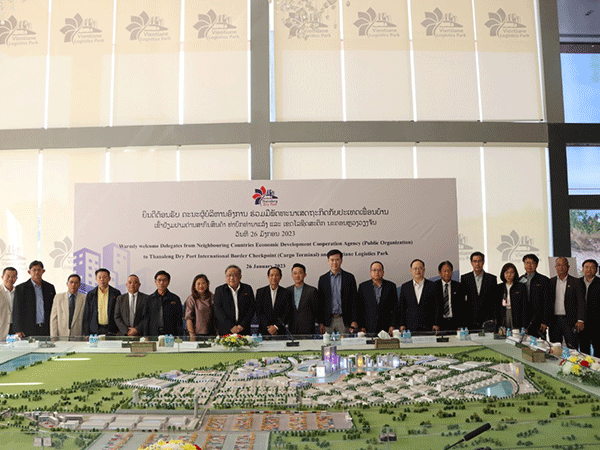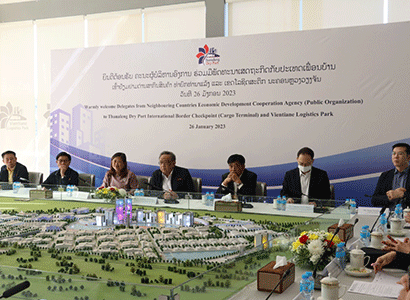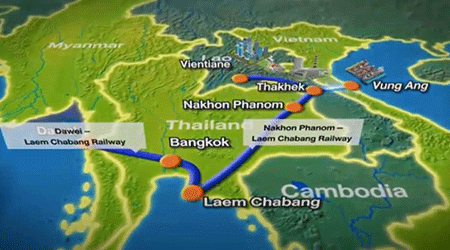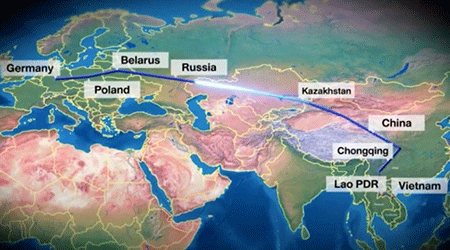 |
| Mr Viengkhone Sitthixay (10th left), company executives and the Thai delegation gather for a group photo. |
Thanaleng Dry Port’s cost-effective logistics services offer great opportunities, Thai delegation told
The cost-effective logistics and transport services provided by the Thanaleng Dry Port offer great opportunities to investors, the project developer has told a Thai delegation.
Delegates from Thailand’s Neighbouring Countries Economic Development Cooperation Agency last week visited the dry port and its associated Vientiane Logistics Park to learn about the opportunities available to them.
Via the dry port, which houses extensions of the Laos-China and Laos-Thailand railways, rail transport takes just four hours to shift goods from Thailand to China through Laos, the dry port’s Managing Director, Mr Sakhone Philangam, said.
 |
| The Thai delegation is briefed about the Thanaleng Dry Port and Vientiane Logistics Park. |
 |
| The dry port and logistics park links to logistics centres in the region. |
The dry port and logistics park are part of the packaged Lao Logistics Link (LLL) project, which also includes the Vung Ang seaport in Vietnam’s central Ha Tinh province and a planned railway to link the seaport with the dry port.
Through the Vung Ang seaport, freight transport takes just 18 hours from Thailand to reach the Chinese market of more than 1.4 billion consumers, Mr Sakhone told the Thai guests.
“This is very important,” the director said.
Transport via the Vung Ang seaport also leads to countries in the Pacific region.
Being built on 382 hectares of land near the first Laos-Thailand Mekong Friendship Bridge, the US$727 logistics park and dry port project is aimed at facilitating logistics and transport, thus cutting costs and increasing trade competitiveness, while also attracting more investment.
Vice President of Vientiane Logistics Park Co., Ltd., Mr Viengkhone Sitthixay, said a China Certification and Inspection Group (CCIC) representative unit will be stationed at the logistics park to inspect and issue Chinese standard certification. Equipment is being installed to facilitate inspections.
China’s sanitary and phytosanitary (SPS) centre will also be set up to certify farm products.
“Inspections can be carried out here without having to do it again at the Chinese border,” Mr Viengkhone said.
Already, exporters in Thailand, one of the region’s major crop growers, have shipped goods, especially farm products, to China via the dry port and railways. Faster transport enables fruit and vegetables to stay fresh so they reach Chinese buyers before spoiling.
Mr Viengkhone said cold chain facilities and warehouses are being built at the logistics park to store products, especially frozen goods and farm produce.
Given that electricity fees in Laos are half the price of those in Thailand, investment zones being developed inside the logistics park offering lucrative opportunities for Thai entrepreneurs engaged in processing or re-packaging businesses.
 |
| The Laos-China Railway links to the China-Europe rail network. |
Products that are at least 40 percent processed in Laos are eligible for Laos’ country of origin status and can get privileged access to Chinese and European markets, Mr Viengkhone told the guests.
“This means that Thai SMEs [small and medium enterprises] can access more markets,” the vice president said, adding that manufacturers in Laos can also access European markets through the rail network.
Through the Laos-China Railway, which links to the China-Europe rail network, goods can reach European markets in two to three weeks.
Meanwhile, specialised investment zones being built include a tank farm, export processing centre, logistics park, free trade zone, and technology and halal hubs. These zones are expected to be operational by the end of this year.
Businesses operating in these zones can benefit from a number of incentives, including tax breaks for a maximum of 16 years.
By Advertorial Desk
(Latest Update January 30, 2023)
|